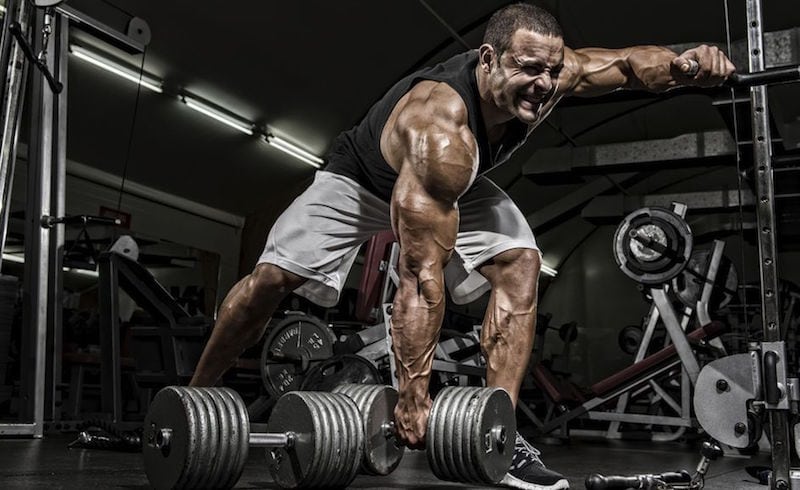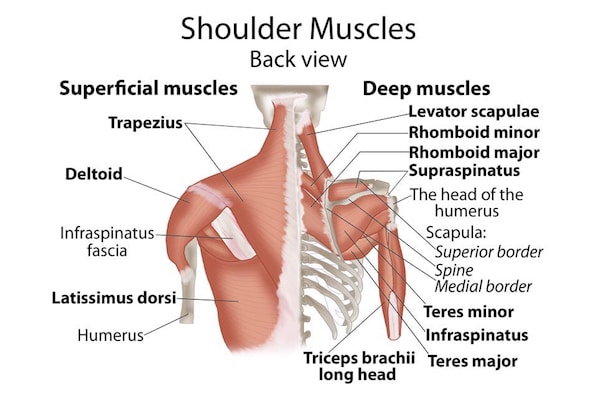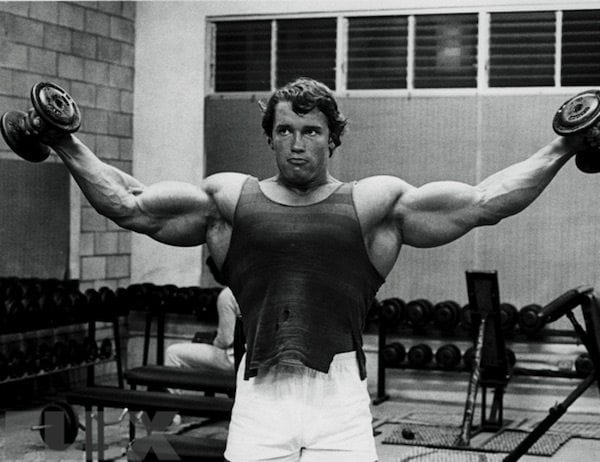No products in the cart.
Essential Strategies for Bigger and Broader Shoulders

Building bigger and stronger shoulders is a difficult task, some people never manage it. Others do manage it, but it takes them longer than it should have.
If you follow a stupid program long enough you will eventually get results! But hopefully you aren’t planning on following a stupid program, and you are looking for an efficient program that will get you good results in a short time.
To build any muscle there are three things you must consider, these are:
- Training Program
- Diet
- Sleep
Most people pay close attention to training, some people work on both training and diet, but very few pay any attention to sleep.
Study after study has shown that sleep plays a massive role in boosting growth hormones and testosterone [1], improving athletic performance [2], and improving mood [3]. It is also during sleep that Muscle Protein Synthesis operates at peak levels (particularly if you take Casein before bed)[4].[toc]
Anatomy of the Shoulders

The shoulder is made up of three bones; The Scapula (otherwise known as the shoulder blade), The Clavicle (or collarbone), and The Humerus (or the upper arm). They are held together by the Glenohumeral Joint (or shoulder joint).
The main muscles in the shoulder are the Deltoid muscle and Rotator Cuff, though some people include The Trapezius muscle and other muscles as well.
The Deltoid is one muscle with three heads, these are sometimes mistaken as three separate muscles but in actuality, it is one muscle made up of three different fibre types (or heads). These are:
- The Anterior Deltoid
- The Middle Deltoid
- The Posterior Deltoid
Recently it has been discovered that there are as many as 7 different sets of fibres [5], but the three mentioned are the ones we will be concentrating on.
The Rotator Cuff Muscles are a group of muscles that stabilise the shoulder, these muscles are:
- The Supraspinatus Muscle
- The Infraspinatus Muscle
- The Teres Minor Muscle
- The Subscapularis Muscle
Training these muscles alone could be the best change you make to your shoulder program, but we still have one more muscle to check out. This is the Trapezius muscle, often thought of as exclusively an upper back muscle, the Trapezius extends from one shoulder to the other at its widest point.
One of its prime roles is to retract and medially rotate the Scapulae. So whilst it is not wrong to call the Trapezius an upper back muscle, it also has a very important role as a shoulder muscle.
Nutrition Strategy for Shoulders
When it comes to building bigger shoulders you are probably going to need to increase calories, if you’re worried that you aren’t lean enough then that’s fine but you should change your goals.
Stop worrying about shoulders and start training/dieting to get as lean as possible.
For those of you who are ready to build bigger shoulders, accept that you are going to have to ‘bulk‘ to increase muscle size.
We’re not talking about adding 1,000 calories to your diet tomorrow, just adding extra protein to your diet to allow Muscle Protein Synthesis to work at an optimal level [6].
The fact of the matter is that it is almost impossible to build muscle when you aren’t in a caloric surplus (not including brand new lifters).
Eat lots of protein if you want to build your muscles, also eat lots of carbohydrates, and prepare to put on some body fat.
This is a sad but inevitable part of bulking, and shying away from doing this will leave you with small and weak shoulders.
Training Strategies for Shoulders
There are a lot of different ways to effectively train shoulders, some gym-goers swear by German Volume Training or 5×5, others believe in super-sets or training to fatigue with drop sets and triple drop sets.
Here we will be looking at a few strategies that work, but you don’t have to follow all of the advice at once, just pick what works for you.
Strategy #1: Eccentric Training
Eccentric training involves only training the muscles when they are lengthening, for example an eccentric bicep curl would only involve you lowering the weight back down from the top of the movement. The concentric ‘curl‘ would be ignored.
This allows you to use a much heavier weight as your muscles are stronger during the eccentric part [7].
There are many benefits to eccentric training, it lowers injury risk [8], increases flexibility [9], and most importantly of all eccentric training can increase muscle Hypertrophy [10].
Eccentric training would work well with seated shoulder pressing, but you would need a spotter to help place the weights in your hands at the top of the movement.
Strategy #2: Use Drop Sets
Training to muscle fatigue can be a very effective training strategy, so long as it is used for the short term. Doing it non-stop will slowly lower its effectiveness.
Adding it to the end of a session for a few weeks will ensure you get the most out of drop sets.
An excellent use of drop sets would be adding them into a machine shoulder press, perform as many reps as you can on a heavyweight, and then immediately lower the weight to 50% of the total.
Strategy #3: Use Free Weights Over Machines
Obviously, you shouldn’t ignore machines completely, we just looked at a great use for the shoulder press machine!
But, free weights should make up the majority of your shoulder exercises.
This is because free weights activate more muscle fibres than machines do, and produce a greater hormonal response [11].
Strategy #4: Follow a Full Body Routine
Rather than training shoulders on their own once per week, you will find that you get better results when you train them multiple times per week [12] as part of a full-body routine.
This will allow you to train them maximally in one session, then rest until the next session where you can train them maximally again.
Trying to complete all shoulder exercises one after the other will leave you fatigued after two exercises, do you think that you will be able to get the most out of the third exercise after destroying your delts during the first two?
Strategy #5: Don’t Neglect Your Rear Delts
The Deltoid muscle is made up of three heads, these heads are known as the Anterior Deltoid (front), Lateral Deltoid (Middle), and Posterior Deltoid (Rear).
When you perform bench presses or shoulder presses, or front raises you are working the Anterior Deltoid head.
When you are performing lateral raises you are working the Lateral head, and when you perform rear delt flyes, bent over rows, or face pulls you are working the Posterior head.
As you can see the front delt is the most commonly worked muscle, and most Bodybuilders put a lot of work into the Lateral Deltoid as they believe it makes their shoulders look wider, but the rear delt often gets neglected.
Even when people do train it, it is usually done as an afterthought if they have time left at the end of the session. Instead, treat them as the most important muscle and train them during the ‘back‘ part of your workout.
Best Exercises for Shoulders
When it comes to building boulder shoulders there is one exercise that comes to mind, the bench press.
However, it is certainly not the only way to build impressive shoulder muscles. In fact, if you bench press too often you may find that your progress may be halted.
I bet a few of you reading this have experienced shoulder pain thanks to the bench press. So what can you do instead?
The following are 4 other moves that will help you to build those huge boulder shoulders to be proud of:
#1: Overhead Press
Before the bench press became so popular the overhead press was one of the best exercises for building your shoulder muscles.
In the real world, you would be more likely to lift something above your head rather than lifting something while laying on your back, so the overhead press will deliver real-life actions, which often produce the best results.
The overhead press is not only a good exercise for the shoulders, but if you are serious about building proportionate amounts of muscle across your entire body then this exercise is for you.
If performed with the correct form the overhead press can work the following muscles:
- Shoulders
- Abs
- Triceps
- Lower back
- Traps
- Serratus anterior
- Upper thighs
#2: Seated Dumbbell Shoulder Press
This movement works in a similar fashion as the overhead press, but as you are seated you will be able to specifically focus on your shoulders.
Doing so will encourage significant muscle growth in these specific muscles.
#3: Pike Push-Ups
The pike push-up is basically the same as an ordinary push-up, except for the fact that your legs are raised off the ground, perhaps on a bench or a stability ball.
This action forces you to put for emphasis onto your shoulder muscles, rather than your chest.
These pike push-ups are also a good exercise for your abs, but just be careful not to do these to exhaustion as you most certainly do not want to be falling onto your face.
#4: Face Pulls
Face pulls are a great exercise for the rear delts, the rotator cuffs, and other small muscles of the shoulder.
It is a great warm-up, will improve range of motion, and will help strengthen these crucial muscles, leading to bigger, more rounded shoulders.
Start each shoulder and chest workout with three sets of face pulls.
Common Shoulder Workout Mistakes

When training shoulders you should try to avoid the following mistakes:
Reason #1: You Don’t Train Them Enough
A lot of people tend to react to difficulty by ignoring the problem, even if they don’t know they’re doing it. As a result, people who say that they struggle to build their legs, tend to neglect them.
Same with calves, or arms, or yes shoulders! If you are struggling to build your shoulders then maybe it’s because you’re not training your shoulders enough.
Consider adding in an extra 3-4 different shoulder exercises into your week.
Reason #2: You Don’t Train Hard Enough
Are you lifting heavy enough? Are you training to muscular fatigue? Do you walk out of a shoulder workout physically and mentally drained?
If not, ask yourself if you treat shoulders with the same amount of respect that you treat chest. If not you might realise why your shoulder gains are not as impressive.
Reason #3: You Try To Be Too Clever
Are you throwing drop sets in? Do you try front delt raises that transform into lateral raises? Are you experimenting with differing rep ranges? Is there a Bosu Ball anywhere near you right now? If you answered yes to any of those questions and you are struggling to get bigger shoulders, then maybe you’re overcomplicating things.
Lift heavy standing shoulder presses (or push presses) for three to four sets, and give yourself extra-long rests in between sets.
Try this out twice per week (with some additional exercises that we will mention in a bit) and check your results.
Reason #4: You Train Chest and Shoulders Together
Now, there is nothing wrong with training chest and shoulders together as part of a full-body workout.
In fact, not performing a full-body workout could be one of the mistakes that you are making, as this will allow you to train the muscles more often throughout the week which leads to increased strength [13].
But training one or two muscles together such as back and biceps is a bodybuilding staple. In this case, putting chest and shoulders in the same workout is a pretty big mistake.
This is because the most common chest exercises; Bench Press, Dips, Press Ups are also Anterior (front) Deltoid exercises.
As a result, you are now training the front deltoid for all of the chest exercises and then expecting to train the front deltoid for all of the shoulder exercises; Front Raises, Shoulder Press, Military Press etc …
This will 1) Over-train the Front Deltoid creating an imbalance of the Deltoid group 2) Prevent yourself from maximising your shoulder workout as your muscles will already be fatigued from the chest exercises.
Reason #5: Ignoring The Middle And Posterior Delts
This was touched upon in the last point, but the middle and posterior delts are just as important for a healthy and strong shoulder as the anterior delts.
Building bigger middle deltoids isn’t just good for shoulder health, they are also a good ‘mirror muscle‘ in that they can make your shoulders wider which will, in turn, improve your shoulder to waist ratio.
But the rear delts are the most important muscle to concentrate on, poorly worked rear delts can lead to rotator cuff injuries and bad posture.
Rear delts don’t need to be trained in isolation, they can be worked while performing most rowing movements, particularly the bent-over row or single-arm row. Adding rear delts to a back workout, or the pull day for a push/pull program can really help you fit them into your program.
Reason #6: Performing The Upright Row Badly
The Upright row has become the least popular exercise with physiotherapists because it is so often performed incorrectly.
When most people perform the Upright Row, they tend to place their hands very close together in the middle of the bar when they should actually space their hands out wider.
Another big mistake is raising the elbows above shoulder height. Schoenfeld et al (2015) demonstrated that modifying the exercise so that the elbows do not pass shoulder height could prevent any rotator cuff injuries from occurring [14].
Reason #7: Arching Your Back During Shoulder Press
This could be put another way, don’t use more weight than you are comfortable lifting.
The reason is that during a shoulder press (particularly the military press) if the weight is too heavy the lifter will subconsciously arch their back so that they can almost turn the movement into a bench press. By arching your back you are recruiting your upper pectorals to help you lift.
This will cause havoc in your Erector Spinae muscle group, and will eventually lead to injury.
It also leaves you with a pretty poor shoulder workout as you are now taking away the emphasis of the front and middle delts, and placing it on your pectorals.
Lower the weight and make sure that you are fully upright when performing this exercise.
Reason #8: You Don’t Pay Attention To Your Traps
You will never be able to shoulder press, front raise, side raises, or perform an Arnold press without big traps.
The trapezius muscles will also help to make your shoulders appear broader and more rounded.
Try to work them as regularly as you do the deltoids. Use barbell shrugs, upright rows, and farmer’s walks to build these muscles.
Reason #9: You Aren’t Sleeping Enough
One of the most underrated factors when it comes to trying to build muscles is the issue of sleep.
Getting a good night’s sleep is crucial for adequate recovery from exercise. Most of muscle protein synthesis occurs while we are in a deep sleep.
Getting countless bad nights in a row can increase Cortisol (the stress hormone that can cause muscle loss) and lower testosterone and growth hormone (both required for muscle gain).
Aim for at least eight hours, more if you have had a particularly intense session.
In Conclusion
Be consistent, work hard, eat well, train your shoulders often, don’t neglect your middle and rear deltoids (or your trapezius), and make sure that you are getting adequate sleep.
Do all of these things and you can expect big boulder shoulders in no time.
Save
SaveSave
